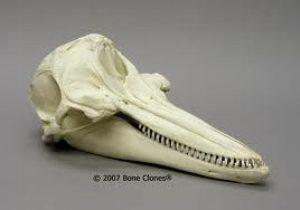
Scientists think that dolphin’s teeth aren’t just for grabbing – a hypothesis that is gaining considerable support suggests that dolphin teeth might be used as an antenna. Not an antenna for picking up radio or television signals (dolphins probably aren’t too bothered if they miss an episode or two of Survivor), but for detecting sonar signals. Learn more about the strange properties of dolphin teeth in this week’s episode.
Not all teeth are created equal. Some animal teeth are for grinding and chewing (like the human molars), some for tearing and cutting (like the human incisors). Other kinds of teeth are used to puncture (like a snake’s), or to grasp and crush (like an alligator’s). It all depends on the different dietary needs of the animal in question. Dolphins, for example, have rounded, cone-shaped teeth that are useful for catching and holding onto fish; dolphins don’t chew, they grab their prey and then swallow them whole. But scientists now think that dolphin’s teeth aren’t just for grabbing – a hypothesis that is gaining considerable support suggests that dolphin teeth might be used as an antenna. Not an antenna for picking up radio or television signals (dolphins probably aren’t too bothered if they miss an episode or two of Survivor), but for detecting sonar signals.
This hypothesis has actually been around for over 15 years (The original hypothesis: Goodson, A.D. and M. Klinowska. “A Proposed Echolocation Receptor for the Bottlenose Dolphin (Tursiops truncatus): Modelling the Receive Directivity from Tooth and Lower Jaw Geometry”, in Thomas and Kastelein, eds, NATO ASI Series A: Sensory Abilities of Cetaceans, vi.196:255-267 (Plenum NY, 1990), but recent research is starting to provide evidence that dolphins do indeed posses a lower jaw that is essentially a sonar antenna. There are two strange facts concerning both dolphin teeth and the dolphin jaw that lend support to this hypothesis. The first is that, unlike most animals, dolphin teeth are all uniformly shaped – a phenomenon called homodontism, a word which means essentially same-toothidness. The second fact is that the dolphin jaw has a very peculiar configuration; the teeth are arranged in identical rows with the jaw tapering at about a 10° angle. The significance of these two facts is clear once we understand a little bit more about what it is that the teeth might actually be used for.
First, I’ll need to explain the term resonance. In acoustical physics, resonance occurs when a sound wave of a specific frequency oscillates at a maximum volume. This is caused because the object or material in which the sound wave is trapped, or in which it is traveling has physical properties that just so happen to allow for vibrations to occur at that exact frequency much easier than at other frequencies. This is the basic principle behind most musical instruments. The strings on a guitar have a frequency with which they vibrate (or resonate) the easiest when plucked, and the body of a violin is shaped in such a way that it allows certain frequencies to resonate, essentially making them louder. It is the size and construction of the material that determines which frequencies will resonate.
Well, evolution has provided dolphins with their own set of mini-resonators – that is, dolphin teeth. Dolphin teeth appear to have a structure that helps facilitate a very helpful kind of resonance. Scientists at Loughborough University have recently conducted experiments to show that the teeth of bottlenose dolphins resonate at frequencies between 115 and 135 kHz – that just so happens to be the exact range in which the main frequency of bottlenose dolphins’ echolocation clicks are known to work. This is unlikely to be a coincidence – having a jaw full of teeth that all resonate at ~120kHz is an amazingly useful tool, if you’re a dolphin. You might remember from previous episodes of The Dolphin Pod that dolphins hear with their lower jaw – check out the Dolphin Pod website in order to brush up on your knowledge of dolphin echolocation and dolphin hearing.
What this means is that as a dolphin sends out echolocation clicks and then listens to the returning click echoes, the teeth in their jaw will all be resonating at 120kHz, essentially amplifying the frequency at which their click echoes are found. It is a fantastically simple means of amplifying the sound of their returning echolocation clicks.
The arrangement of the rows of teeth in the jaw in that 10° taper-formation also helps with this amplification process. Bottlenose dolphins have about 22 teeth in each row for each jaw, and all the teeth are evenly separated by about 1 cm. This arrangement helps the dolphin’s jaw to best be able to receive echolocation clicks in a narrow beam projecting forward of its jaw. The spacing of the teeth also allows for the reception of sound at each of the teeth to all find their way back to the dolphin’s middle ear at the exactly the same time – boosting the overall volume. This configuration is almost exactly like you see in radio and TV antennas that are stuck up on rooftops.
So, the next time you look at a dolphin’s smiling face with a jaw full of cute pointy teeth, keep in mind that that jaw, those teeth and that dolphin smile may have evolved first and foremost as a giant sonar antenna. Being able to catch and hold fish with your antenna… well, that’s just an added bonus!
A recently published article going into great detail about the acoustic properties of dolphin teeth, and how they could potentially act as an antenna: Scientific article about dolphin ‘antenna teeth’
